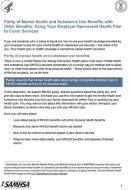This brochure gives an overview of the Mental Health Parity and Addiction Equity Act of 2008. It lists some of the common limits placed on mental health and substance use disorder benefits and services.
Dashboard: Filter Bricks
Main page content


This document provides an overview of essential information necessary for understanding mental health and substance use disorder parity and how to implement and comply with federal parity laws. This guide applies to parity laws in employer-sponsored health plans and group and individual insurance.

There are protections in federal law, collectively known as “parity,” which are designed to ensure that certain types of health plans cover mental and substance use disorders no less generously than they cover other health issues. This resource can guide you to helpful materials and places.

This resource describes the Mental Health Parity and Addiction Equity Act of 2008 for people with employer-sponsored health plans who need treatment for mental and/or substance use disorders. It discusses how to file a claim, the denial of a claim and the appeals process.

This comic book presents basic information about hepatitis C for people living with mental illness or substance use disorders. It uses plain language and a simple cartoon style to explain what hepatitis C is, how to avoid it, the screening process, and treatment options.

This guide provides practical information to clinicians and other professional care providers who treat women living with substance use disorders. It addresses risk factors, mental illness and substance use screening, patient assessment, treatment, and relapse.

This quick guide helps clinicians address the specific needs of women living with substance use disorders. It reviews gender-specific research and best practices—such as common patterns of misuse—and specific screening and treatment strategies.

